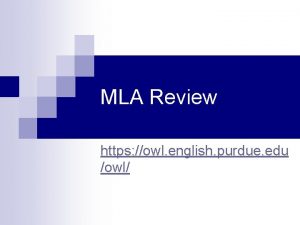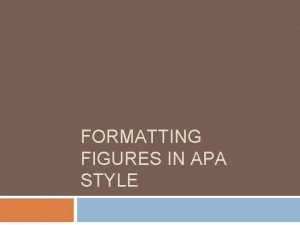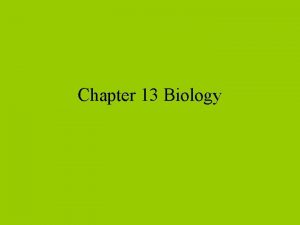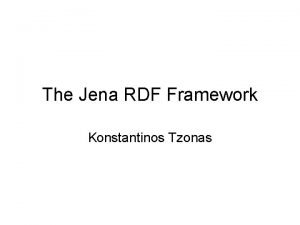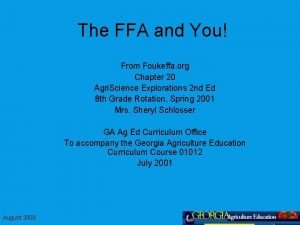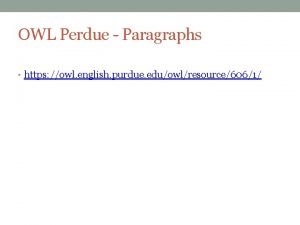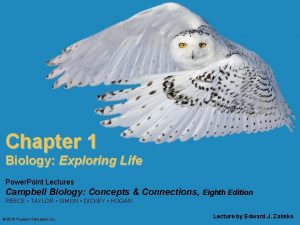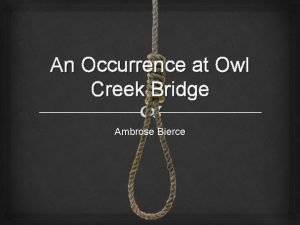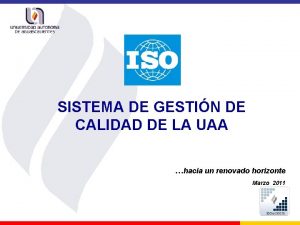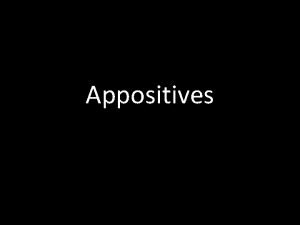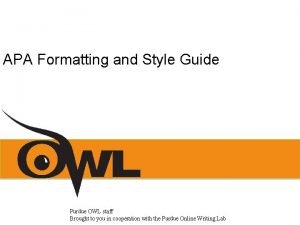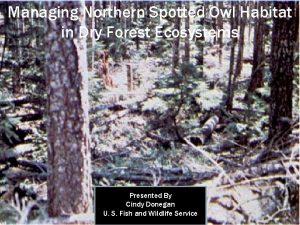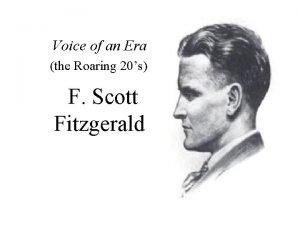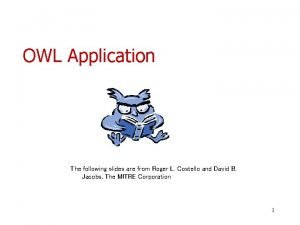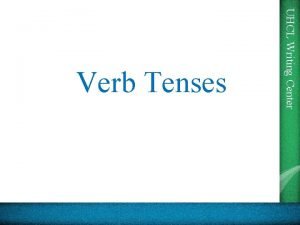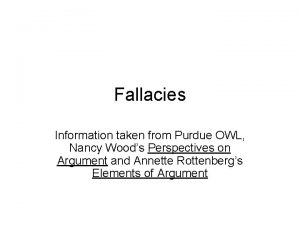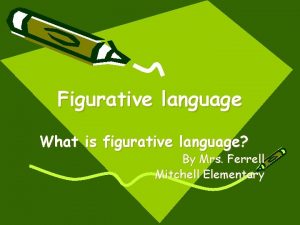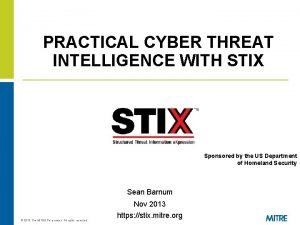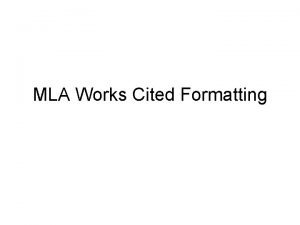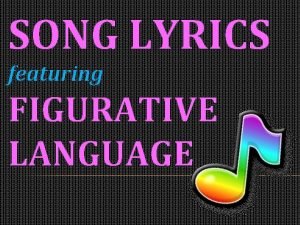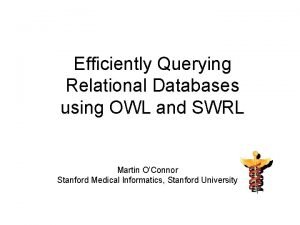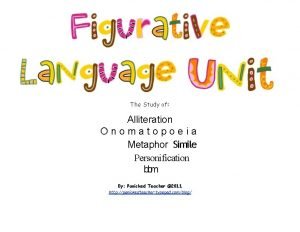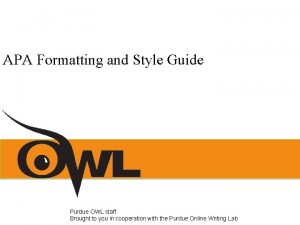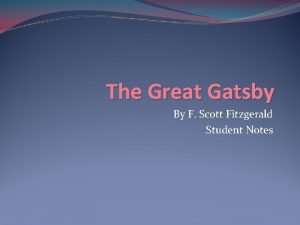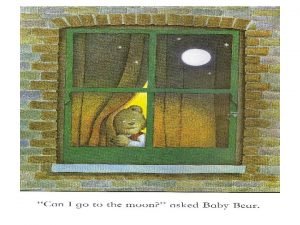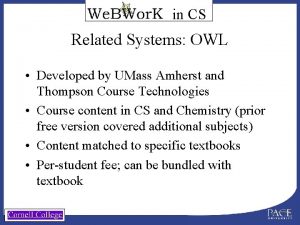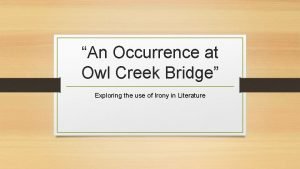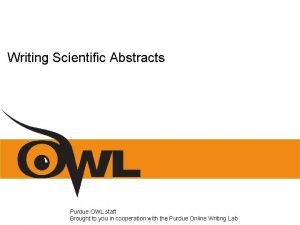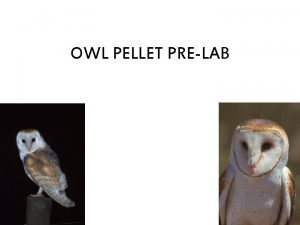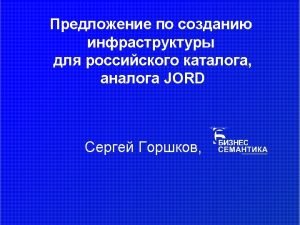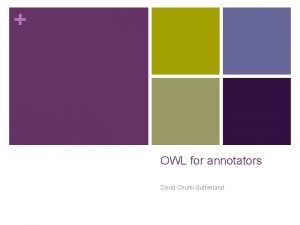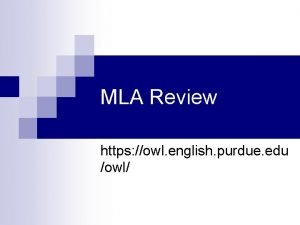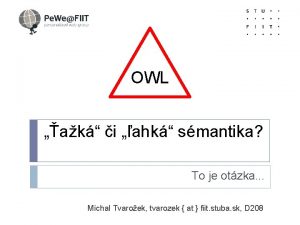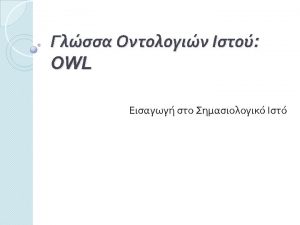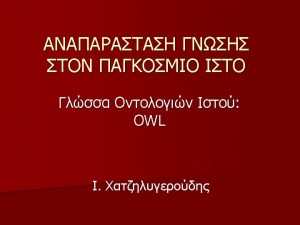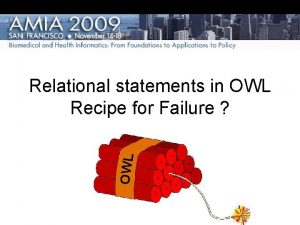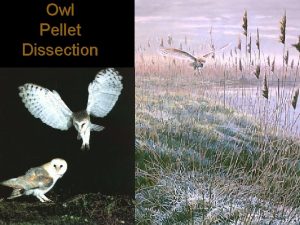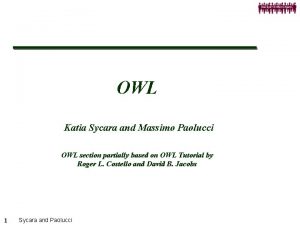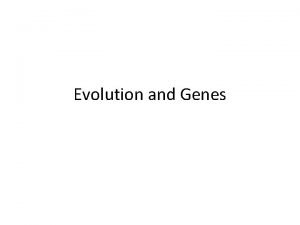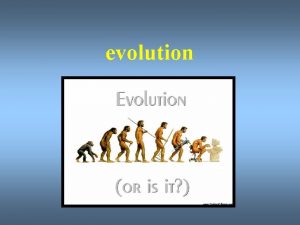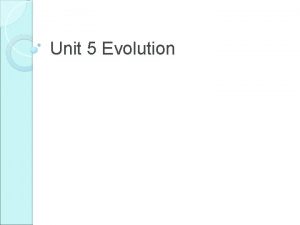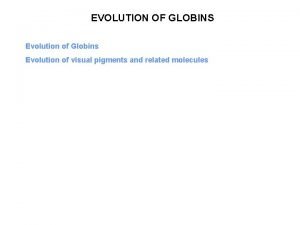Evolution in OWL 2 QL OWL 2 EL









![Previous Work Model-based operators Formula-based operators Many evolution operators proposed [AGM’ 85] [Borgida’ 85] Previous Work Model-based operators Formula-based operators Many evolution operators proposed [AGM’ 85] [Borgida’ 85]](https://slidetodoc.com/presentation_image_h2/df58052d1be3ac598dca9ae378500270/image-10.jpg)



























- Slides: 37

Evolution in OWL 2 QL & OWL 2 EL Ontologies Dmitriy Zheleznyakov 28 th of January, 2014, Oslo

Ontology General rules: o To use ontologies in applications, we need special, formal syntax All popes are clerics Facts: Benedict XVI is a pope 2

Ontology o Do ontologies differ from data bases? o Data bases: explicit knowledge only o Benedict XVI is a pope o Ontologies: explicit & implicit knowledge o Benedict XVI is a pope o Reasoning: Benedict XVI is a cleric reasoning Explicit knowledge Implicit knowledge 2

Ontology Languages o The focus of this work: ontology languages for the Semantic Web o Web Ontology Language: OWL 2 (W 3 C Standard) o OWL 2 QL o OWL 2 EL o Good computational properties o Efficient schema and data management o Used in practice 3

OWL 2 QL: Ontology-Based Data Access o Ontology-Based Data Access (OBDA) o provide unified query interface to heterogeneous data sources 4

OWL 2 QL: Ontology-Based Data Access o Ontology-Based Data Access (OBDA) o provide unified query interface to heterogeneous data sources o EU FP 7 project Optique will develop an OBDA system o use-case partners: Statoil, Siemens o Ontologies may change: o new knowledge about domain o new data source is added o Motivation for our work: o to address the dynamicity of OBDA systems by studying evolution of schema and data 4

OWL 2 EL: Clinical Science, Bio Ontologies enable communication and knowledge sharing between doctors, scientists, etc. o SNOMED CT: > 311 k terms o constantly under development: o 5 modification teams o every 2 weeks the main team integrates changes, o 2002 2008 SNOMED went 278 k 311 k terms o It is the standard to describe the results of experiments in the US clinical labs o Motivation for our work: o to provide techniques that facilitate ontology development for such a vast community 5

Our Goal o To facilitate evolution of ontology-based systems o insertion of knowledge o deletion of knowledge o On two levels: o schema o data Original ontology To insert o With as little changes as possible To delete 6

How to Approach the Problem? Original ontology 1. Define an operator and understand it New knowledge • a conceptual understanding of how to evolve ontologies • checking its computational properties 2. Develop an algorithm to compute the result 3. Implement the algorithm Resulting ontology 7
![Previous Work Modelbased operators Formulabased operators Many evolution operators proposed AGM 85 Borgida 85 Previous Work Model-based operators Formula-based operators Many evolution operators proposed [AGM’ 85] [Borgida’ 85]](https://slidetodoc.com/presentation_image_h2/df58052d1be3ac598dca9ae378500270/image-10.jpg)
Previous Work Model-based operators Formula-based operators Many evolution operators proposed [AGM’ 85] [Borgida’ 85] [Dalal’ 88] [Winslett’ 88] [Satoh’ 88] [Katsuno&Mendelzon’ 91] [Winslett’ 90] AI: 80’s – 90’s Propositional logic, weaker then OWL 2 QL & OWL 2 EL Adaptation of some operators [Kang&Lau’ 04] [Liu& al’ 06] [Flouris&al’ 04] [Qi&Du’ 09] [Flouris&al’ 05] [De. Giacomo&al’ 07 -09] [Qi&al’ 06] [Wang&al’ 10] KR: 2004 -2006 2007 -2010 8

General Overview of the Results Work for restriction of OWL 2 QL Model-based operators Formula-based operators Propositional logic 1 4 OWL 2 QL OWL 2 EL 2 3 Bold operator Works for OWL 2 QL Tunable operator Works for OWL 2 QL & EL 5 6 For OWL 2 QL & EL - inexpressibility OWL 2 QL - counterintuitive results OWL 2 EL - inexpressibility - counterintuitive results 9

Understanding Model-Based Operators Work for restriction of OWL 2 QL Model-based operators Formula-based operators Propositional logic 1 4 OWL 2 QL OWL 2 EL 2 3 Bold operator Works for OWL 2 QL Tunable operator Works for OWL 2 QL & EL 5 6 10

Understanding Model-Based Operators o We have shown: operators are determined by three parameters o this gives a three-dimensional space of operators o Classical operators fit in this space o Novel operators can be easily defined by changing parameters 11

Understanding Model-Based Operators o We noticed: operators are determined by three parameters o this gives a three-dimensional space of operators o Classical operators fit in this space o Novel operators can be easily defined by changing parameters o We can add new values to dimensions! o more operators can be defined! 11

Inexpressibility of Model-Based Operators Work for restriction of OWL 2 QL Model-based operators Formula-based operators Propositional logic 1 4 OWL 2 QL OWL 2 EL 2 - inexpressibility - counterintuitive results 3 Bold operator Works for OWL 2 QL Tunable operator Works for OWL 2 QL & EL 5 6 12

Inexpressibility of Model-Based Operators Schema: Wives are married to their husbands Priest cannot be husbands Facts: Mary is married to John and Adam and Bob are priests 13

Inexpressibility of Model-Based Operators a model: Priest Adam has. Husband Mary John Bob Under model-based operators: We incorporate new knowledge directly into models Facts to add: John is a priest 13

Inexpressibility of Model-Based Operators Priest Adam has. Husband Mary 1. has. Husband Adam John Bob John cannot be a husband of Mary anymore! What happens to her? Priest John 2. Three options: 1. She divorced 2. She married some one else 3. She married to a former priest Priest Adam has. Husband Mary Jack Bob John 3. Priest Adam has. Husband Mary Bob John 13

Inexpressibility of Model-Based Operators Priest Adam has. Husband Mary 1. has. Husband Adam John Bob We showed: all these options cannot be captured in OWL 2 QL and OWL 2 EL Priest John OR 2. Priest Adam We need at least disjunction which is not in OWL 2 QL and OWL 2 EL has. Husband Mary Jack Bob John OR 3. Priest Adam has. Husband Mary Bob John 13

Bad Behaviour of Model-Based Operators Work for restriction of OWL 2 QL Model-based operators Formula-based operators Propositional logic 1 4 OWL 2 QL OWL 2 EL 2 - inexpressibility - counterintuitive results 3 Bold operator Works for OWL 2 QL Tunable operator Works for OWL 2 QL & EL 5 6 14

Bad Behaviour of Model-Based Operators Some of model-based operators behave as follows: No schema Facts: Adam and Bob are priests Facts to add: John is a priest 15

Bad Behaviour of Model-Based Operators Some of model-based operators behave as follows: Priest Adam Bob Such behaviour is not useful for any application Expected result: Priest Adam Actual result: Priest John Bob John 15

Restriction of OWL 2 QL Work for restriction of OWL 2 QL Model-based operators Formula-based operators Propositional logic 1 4 OWL 2 QL OWL 2 EL 2 3 Bold operator Works for OWL 2 QL Tunable operator Works for OWL 2 QL & EL 5 6 16

Restriction of OWL 2 QL o We found the reason of the bad behaviour of model-base operators: A binary relation participates in disjointness o Priest cannot be husbands o What if we forbid this bad interaction? o We showed: most of model-based operators work! o this fragment captures (FO part of) RDFS (another W 3 C standard) Priest Adam has. Husband Mary John Bob disjoint with 17

Summing up on Model-Based Operators o Model-based operators o suffer from inexpressibility o tend to lose too much of information o counterintuitive behaviour o Our verdict: o model-based operators are not suitable for the case of OWL 2 QL or OWL 2 EL o We turned to Formula-based operators! 18

Formula-Based Operators Work for restriction of OWL 2 QL Model-based operators Formula-based operators Propositional logic 1 4 OWL 2 QL OWL 2 EL 2 3 Bold operator Works for OWL 2 QL Tunable operator Works for OWL 2 QL & EL 5 6 - inexpressibility - counterintuitive results 19

Formula-Based Operators o Preserve all the knowledge: both explicit and implicit o Example: delete Priests are Males o We do not want to lose info that Adam is Male Explicit schema Explicit data Implicit schema Implicit data 20

Formula-Based Operators o Preserve all the knowledge: both explicit and implicit o Example: delete Priests are Males Explicit schema Implicit schema o How to delete it in such a way that it will not appear even implicitly? o Delete o either Priests are Clerics o or Clerics are Males 20

Formula-Based Operators o Preserve all the knowledge: both explicit and implicit The resulted schema: either or o Example: delete Priests are Males o How to delete it in such a way that it will not appear even implicitly? o Delete o either Priests are Clerics o or Clerics are Males o What to do with a multiple choice? Classical approaches: o Keeping both – impossible o Combining them o too much of information is lost o we proved: it is computationally hard 20

Bold Operator Work for restriction of OWL 2 QL Model-based operators Formula-based operators Propositional logic 1 4 OWL 2 QL OWL 2 EL 2 3 Bold operator Works for OWL 2 QL Tunable operator Works for OWL 2 QL & EL 5 6 21

Bold Operator There is no way to decide o which result is delete better! Priests are Males Example: This is application dependent and o How to delete it in such a way should be up to the user that it will not appear even implicitly? o Delete o either Priests are Clerics The resulted schema: o or Clerics are Males either or o What to do with a multiple choice? o We propose: Bold operator. It picks up one of them o The result is non-deterministic… o … But can be computed in polynomial time (for OWL 2 QL) o In the case of OWL 2 EL: o Implicit knowledge can be infinite o Bold operator does not work 22

Tunable Operator Work for restriction of OWL 2 QL Model-based operators Formula-based operators Propositional logic 1 4 OWL 2 QL OWL 2 EL 2 3 Bold operator Works for OWL 2 QL Tunable operator Works for OWL 2 QL & EL 5 6 23

Tunable Operator o Tunable operator o allows to choose what part of implicit knowledge will be preserved Explicit schema Implicit schema 24

Tunable Operator o Tunable operator o allows to choose what part of implicit knowledge will be preserved Explicit schema Implicit schema 24

Tunable Operator No implicit part Whole implicit part 25

Summing up on Formula-Based Operators o Classical Formula-based operators o suffer from inexpressibility o tend to lose too much of information o Bold operator: o works for OWL 2 QL o fails for OWL 2 EL o Tunable operator: o works for both OWL 2 QL and OWL 2 EL 26

Current Work o Applying our results to the Optique project o in progress o Incorporating evolution in transition systems o IJCAI’ 2013 o Information hiding & Controlled query evaluation o ISWC 2013 o submitted to an international conference 27
 Owl purdue
Owl purdue Purdue owl figures
Purdue owl figures Owl purdue feminist criticism
Owl purdue feminist criticism Numbers pyramid owl pellet lab
Numbers pyramid owl pellet lab Owl api
Owl api What are the official ffa colors? *
What are the official ffa colors? * Owl@perdue
Owl@perdue Connecting the concepts exploring life
Connecting the concepts exploring life Foreshadowing in owl creek bridge
Foreshadowing in owl creek bridge Owl barn catalogue
Owl barn catalogue Sgc uaa
Sgc uaa Purdue owl appositives
Purdue owl appositives Purdue owl mla
Purdue owl mla Spotted owl
Spotted owl Owl eyes great gatsby
Owl eyes great gatsby Owl
Owl Scannable résumés are:
Scannable résumés are: Purdue owl verb tense
Purdue owl verb tense Purdue owl fallacies
Purdue owl fallacies Language
Language Stix mitre
Stix mitre Owl mla work cited
Owl mla work cited Songs with alliteration clean
Songs with alliteration clean Owl
Owl Who is this
Who is this Basketball alliteration examples
Basketball alliteration examples Apa purdue owl
Apa purdue owl Collaborating owl style
Collaborating owl style Gatsby
Gatsby Produce owl apa
Produce owl apa Bj alex owl
Bj alex owl Rdf owl
Rdf owl President of ffa symbol
President of ffa symbol Owl slides into room
Owl slides into room Umass amherst owl
Umass amherst owl Examples of irony in an occurrence at owl creek bridge
Examples of irony in an occurrence at owl creek bridge Purdue owl mla abstract
Purdue owl mla abstract Luc owl lab
Luc owl lab
